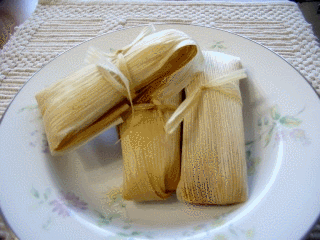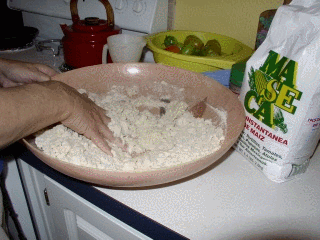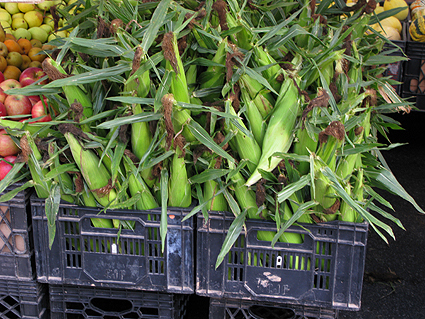
Tamales

|
Tamales
A Holiday Treat |
|
Corn! Straight forward enough of a word. Or, is it? The answer to that question depends on where you are and how you view corn. Is it a grain or is it a vegetable, or is it both at the same time? And it depends on how we use the word. It is the definition in the dictionary versus the local usage of the word. It is how the locals view corn - is it a grain or is it a vegetable - and its place in the field.. A look in the dictionary will give a clue to the dilemma. Corn is the antiquated word used to describe the major grain crop of a local area. There was no corn itself, it was just the major local grain crop, be it wheat, oats, barley or any other grain crop. Corn was just another name for grain. Perhaps it has its origins in the distant pat when early man gathered grains to dry and store for the winter. The grain was then ground to make bread, the staff of life. From corn, then, the major grain crop of the area, we make flour to make bread. That was all well and good until the European explorers found their way to the New World and saw that the indigenous peoples were cultivating maize. Yep! Those yellow (now mostly yellow but in the beginning there were a are a lot of other colors) kernels on the cob are really maize. I can only guess that some where in the Midwest, where maize was the major crop, the term corn was used and the name stuck to maize here in the United States. Here, in the United States, we call wheat, wheat. We call barley, barley. We call oats, oats. We call maize corn. And, to make matters worse, here in the United States, we use corn both as a grain and as a vegetable. We have ground corn, the grain, to make corn meal. The store aisle will have bags of yellow and white corn meals and bags of finely ground corn flour. Clearly this corn is being used as grain. From the corn meal we make pone or cornbread. And a check of any supermarket frozen food display will reveal whole kernel corn, corn on the cob and corn mixed with lima beans to make succotash.. In the canned goods, we have whole kernel corn, creamed corn and corn with sweet peppers. In the fresh produce section, in season, we have corn on the cob still in the husks. This corn is being used as a vegetable. In essence, we haven't decided on the nature of corn, be it grain or vegetable, and we don't call it by its right name, maize. I am reminded of all this when I think of tamales. Or, at least I do when I think of the first time I saw tamales being made. Tamales are a labor intensive dish and are usually made as a family effort. They are usually made for special events, birthdays, holidays and celebrations. In the average Mexican home they are not daily fare but a festive food. I had been visiting in Mexico for several weeks. Although I was enjoying my immersion into the daily life there, quite often I would think of little things from back home that I missed. I was during one of those musings about things back home when there was a commotion outside the house. Every one was hurrying to the street where a vendor with horse-drawn cart was selling corn fresh from the fields. I went outside to watch. The señoras picked over the wares, pulling down the husks to inspect and haggle over price. As I watched over their shoulders, I could see big and succulent ears of corn on the cob. Now there was a little bit of the life back home that had come to seek me out. Things were looking up. The arm-loads of corn were brought inside the house and straight to the kitchen. I watched as the ears were carefully stripped and the husks placed safely aside. I was waiting for a big pot for boiling water to cook the ears. I was aghast when the big knives started cutting the kernels from the cobs. All of those big, beautiful kernels, just waiting to be cooked in boiling water, salted and slathered with butter, and then eaten with gusto, all those kernels were grist for the mill. The corn was ground up to make masa for tamales. I had been looking at the corn and seeing a vegetable. My companions had looked at the corn and seen a grain to grind and make the daily bread. True, the corn had not been dried first and then ground into flour. The corn was simply ground up. The slurry of corn and natural corn juices, with a bit of corn meal, milk and sugar added, made the corn meal dough for the tamales. These are green corn tamales. When fresh corn from the field is not available, the tamale dough is made from ground dried corn, a flour called masa harina. I learned that those carefully stripped husks, after a dunk in boiling water, would wrap the tamales for cooking. I also learned that tamales, in the area of central Mexico, come in two basic varieties: sweet and savory. The sweet tamales are usually filled with a paste made mostly of an unrefined sugar, called panela, raisins and nutmeats, a type of sweet similar to panocha. The savory tamales are filled with a spicy meat mixture, most often it is pork called carnitas. There are also many other fillings for tamales depending on the area and the available foodstuffs. (And if you have had tamales from a can then you haven't had tamales.) All the tamales are steamed together in one huge pot and when they are removed for serving, it is the luck of the draw if you get a sweet or a savory tamale. Included here are recipes from my own experiences both south and north of the border. There are recipes for green corn masa and dough made from masa harina, a corn flour usually available in supermarkets. In a pinch I have made tamales with cornmeal and they taste very good but the texture is very different (more corn-bready than regular tamales). After you have selected your masa, choose from the offered fillings and make a big batch of celebratory tamales. After you have tried my collection of recipes, then try my brother's extended family recipe for authentic Californiano tamales |

|
A Basic Masa
For Tamales |
Ingredients:
|
(Makes about 2 dozen tamales)
|
Procedures:
|

|
Green Corn
Tamale Masa |
|
Makes about 2 dozen small tamales about 4 ounces each. Depending on your location, check your farmer's market mid-summer through the fall for fresh corn. |
Ingredients:
|
|
| Procedures:
Cut both ends of the corn to make removal the husks easier. Save for wrapping. Cut corn kernels off the cob. In grinder, food mill or food processor, grind the kernels while adding the cornmeal. Set aside. Beat shortening and butter together until creamy. Add sugar, half and half and salt. Add corn mixture and mix well. I have seen, on occasion, a bit of sugar or white cheese or diced roasted green chiles added to the masa mixture. |
Filling and Wrapping The Tamales:
|
Sweet Tamale FillingIngredients:
|
|
Procedures:
|
Savory Pork FillingIngredients:
|
Makes about 2 dozen tamales.
|
Procedures:
|
Chile And Carne Machaca Filling For TamalesCarne machaca is really a dried, salted and spiced meat that has been shredded. This recipe mimics carne machaca that has been reconstituted and stewed in a savory sauce. The recipe makes 5 to 6 cups and can nicely fill 2 dozen tamales. The recipe calls for beef but pork can be substituted with tasty results. |
Ingredients:
|
|
Procedures:
|
Pollo Saboroso Filling for TamalesPollo saboroso, literally tasty chicken, is a lighter meat filling for tamales. Breast meat and leg meat are both used to make a balance of texture and flavor. Jalapeño chilies provide the southwestern taste. |
Ingredients:
|
|
Procedures:
|

|